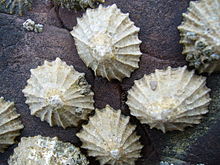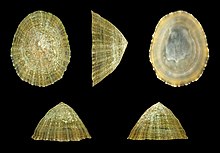Patella vulgata
| Patella vulgata | |
|---|---|
 |
|
| Live Patella vulgata on a rock in Wales | |
 |
|
| A Shell of Patella vulgata | |
| Scientific classification | |
| Kingdom: | Animalia |
| Phylum: | Mollusca |
| Class: | Gastropoda |
| (unranked): | clade Patellogastropoda |
| Family: | Patellidae |
| Genus: | Patella |
| Species: | P. vulgata |
| Binomial name | |
|
Patella vulgata Linnaeus, 1758 |
|
| Synonyms | |
|
|
Patella vulgata, common name the common limpet or common European limpet is an edible species of sea snail with gills, a typical true limpet, a marine gastropod mollusc in the family Patellidae.
This species is found in the waters of western Europe.
The radula in this species is longer than the shell itself. It contains 1,920 teeth in 160 rows of 12 teeth each. It is found attached to firm substrates from the high shore to the edge of the sublittoral zone, although it predominates in areas of wave action. Its shell is conical, up to around 6 cm long, and lacks defined chirality. Common limpets are believed to be able to live for up to twenty years.
Patella vulgata has been the focus of a range of scientific investigation, as far back as 1935. Its development is well described and it has recently been the focus of transcriptomic investigation, providing a range of genomic sequence data in this species for analysis.
Their teeth are the strongest natural material known. A study published in the Royal Society journal in 2015 concluded that "the tensile strength of limpet teeth can reach values significantly higher than spider silk, considered to be currently the strongest biological material, and only comparable to the strongest commercial carbon fibres.” The material was able to withstand 4.9 GPa. This considerable tensile strength of limpet teeth is attributed to a high mineral volume fraction of reinforcing goethite nanofibres.
Four Patella vulgata limpets on a rock in northwestern Galicia. One turned over to show the underside and muscular foot
Shells of the common limpet from Wales
Patella vulgata in litoral of Finistère, near Porspoder - the region affected by the Amoco Cadiz tanker disaster in 1978
...
Wikipedia
